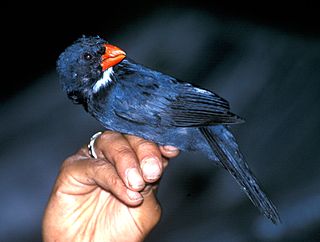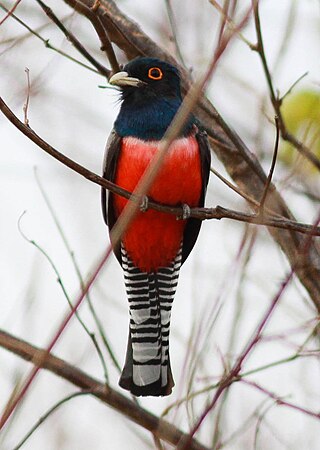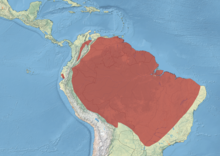
The screamers are three South American bird species placed in family Anhimidae. They were thought to be related to the Galliformes because of similar bills, but are more closely related to the family Anatidae, i.e. ducks and allies,, and the magpie goose, within the clade Anseriformes. The clade is exceptional within the living birds in lacking uncinate processes of ribs. The three species are: The horned screamer ; the southern screamer or crested screamer ; and the northern screamer or black-necked screamer.

The great tinamou is a species of tinamou ground bird native to Central and South America. There are several subspecies, mostly differentiated by their coloration.

The smooth-billed ani is a bird in the cuckoo family. It is a resident breeding species from southern Florida, the Caribbean, parts of Central America, south to western Ecuador, Brazil, northern Argentina and southern Chile. It was introduced to Galápagos around the 1960s and is potentially impacting native and endemic species across the archipelago.

The guira cuckoo is a gregarious bird found widely in open and semi-open habitats of northeastern, eastern and southern Brazil, Uruguay, Paraguay, Bolivia, and northeastern Argentina. It is the only species placed in the genus Guira.

The collared puffbird is a species of bird in the family Bucconidae, the puffbirds, nunlets, and nunbirds. It is found in Bolivia, Brazil, Colombia, Ecuador, French Guiana, Guyana, Peru, Suriname, and Venezuela.

The golden parakeet or golden conure, or the Queen of Bavaria conure is a medium-sized golden-yellow Neotropical parrot native to the Amazon Basin of interior northern Brazil. It is the only species placed in the genus Guaruba.

The brimstone canary or bully canary is a small passerine bird in the finch family. It is a resident breeder in central and southern Africa.

The yellow-green grosbeak is a species of grosbeak in the family Cardinalidae.

The slate-coloured grosbeak is a species of grosbeak in the family Thraupidae. Most of its range is the Amazon in South America, but it is also found in forests of the Chocó in Ecuador and Colombia, and southern Central America from Panama to Honduras.

The spotted puffbird is a species of puffbird in the family Bucconidae, the puffbirds, nunlets, and nunbirds. It is found in Bolivia, Brazil, Colombia, Ecuador, French Guiana, Guyana, Peru, Suriname, and Venezuela.

The Caatinga puffbird is a species of bird in the family Bucconidae, the puffbirds, nunlets, and nunbirds. It is endemic to Brazil.

The coleto is a starling species in the monotypic genus Sarcops. It is endemic to the Philippines. Its natural habitats are subtropical or tropical dry forest, subtropical or tropical moist lowland forest, and subtropical or tropical moist montane forest. In Filipino and Tagalog, this bird is known as kuling or koleto, while in Central Visayas, it is commonly known as the sal-ing.

The red-rumped cacique is a species of bird in the family Icteridae. It is a species of the Amazon Basin and the Guyanas in northern South America, and is only coastal there in the Guyanas and the Amazon River outlet to the Atlantic; a separate large disjunct range exists in all of south-eastern and coastal Brazil, including Paraguay, and parts of north-eastern Argentina. It is also found in Bolivia, Brazil, Colombia, Ecuador, French Guiana, Guyana, Peru, Suriname, and Venezuela.

The balicassiao is a species of passerine bird in the family Dicruridae. It is endemic to the Philippines.

The black-capped donacobius is a conspicuous, vocal South American bird. It is distributed across the northern half of South America.

The purple-throated euphonia is a songbird species in the family Fringillidae. It was formerly placed in the Thraupidae.

The guira tanager is a species of bird in the family Thraupidae.

The campo troupial or campo oriole is a species of bird in the family Icteridae that is found in northeastern Brazil. At one time thought to be conspecific with the Venezuelan troupial and orange-backed troupial, it is now accepted as a separate species. It is a fairly common bird and the International Union for Conservation of Nature has rated it as a "least-concern species".

The short-crested flycatcher is a species of bird in the tyrant flycatcher family Tyrannidae.

The blue-crowned trogon is a species of bird in the family Trogonidae, the quetzals and trogons. It is found in Brazil, Argentina, Bolivia, Colombia, Ecuador, Paraguay, and Peru. As with all trogons, this species is sexually dimorphic. The male has a blue head with an orange orbital ring, a red belly with a narrow white breastband and a green back. The female differs in having a grey head, a grey back and a broken white eye-ring.
























